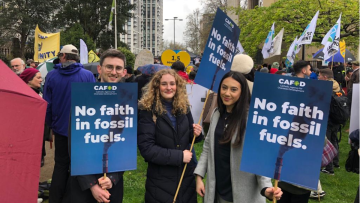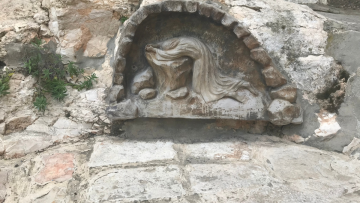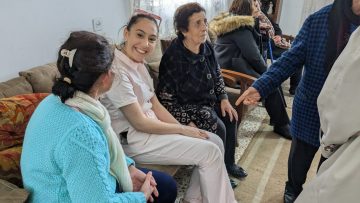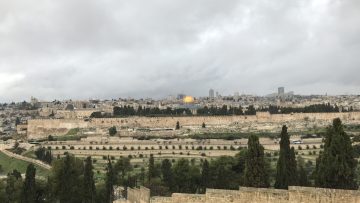Dear Diary: The Holy Land, Days 4 and 5

Bishop John shares snippets of his diary entries during his time in the Holy Land with the Faith in Politics interns.
Day 4 – Thursday 16th March
Thursday morning began with an early start. We left for the Holy Sepulcher at 5.30am so as to be there before the crowds. I happened to arrive at St Helena’s cave (commemorated as the place where St Helena discovered the True Cross) when a small group called Harpa Dei were singing Morning Prayer. It was quite breath-taking in its harmonies and gentleness. The music was so prayerful that those in the chapel did not move until the chanting ended.
The music was so prayerful that those in the chapel did not move until the chanting ended.
We walked to the Pools of Bethesda. This is the place believed to be the site of Jesus’ cure of the paralysed man (John 5:1-14). The site is under the care of the Missionaries of Africa (SMA Fathers). They have the responsibility for St Anne’s Church which is renowned for its acoustic quality and many groups visit in order to sing a hymn or psalm. We celebrated Mass in a newly constructed chapel nearby.

After Mass, we prayed the Stations of the Cross along the Via Dolorosa, a route that has been venerated for centuries. We completed the route and visited the Ethiopian monastery on the roof of the Holy Sepulcher.

We visited the Latin Patriarchate after lunch, just a few yards from the hotel, to meet with the CEO of the Patriarchate, Sami El Yousef. He is the first layman to be appointed to the post and he spoke about the scope of his work. The Patriarchate is the equivalent of a diocese but is exceptional in that it covers Israel, Palestine, Jordan and Cyprus. The regions are beset by a mixture of political problems and a degree of persecution. There is also a vicariate for migrants and refugees, of whom there are an estimated 100,000. With three countries, there are three different legal systems.

In Israel and Palestine, there have been signs of tightening restrictions on the Church, particularly in the matters of finance and taxation which threaten the work of the Church. There has been growing violence towards the Church and its properties, as well as against Catholics. The Patriarchate maintains 45 schools in its territories, with about 19,000 students, and employs 2,000 people of whom 87% are Christians, which is important in providing incomes for the dwindling Catholic community. The Patriarchate is able to provide some school fees, help with medical emergencies and provide social assistance for the poor. There is a need to assist refugees in Jordan and Lebanon and to help with the threatened areas in East Jerusalem where there are property confiscations, and where property can be as much as four times more expensive than other regions of Israel and Palestine.
It was a short walk from there to meet the Custos of the Holy Land. Fr Francisco Patton is the Custos, the Franciscan superior who has overall responsibility for the care of the Holy Places. In 1270, the Franciscans were entrusted with a Mission to protect the Holy Places. This was made more formal in 1342 when Pope Clement VI declared the Franciscans to be custodians of the Holy Places. There are now 84 designated “Holy Places” around the world with the concentration being in the Holy Land. 300 Franciscan friars are co-opted for their care and they come form 11 different countries. It had been part of the Rule of St Francis that Franciscans should minister among Muslim communities. They also have a seminary in Jerusalem, with 60 students. Fr Francisco spoke about the growing difficulty in the increasing appropriation of land by the Government and illegal settlers. As we had already heard more than once, this has cause great distress for non-Jewish Jerusalemite residents and pilgrims.
The Custos emphasised the good relations that exist between the various Catholic religious congregations at work in the Holy Land, and the growing collaboration with interfaith groups. It was a good meeting.

The last meeting of the day was back at the Latin Patriarchate, with Bishop William Shomali, Auxiliary Bishop of Jerusalem and Palestine. He explained his duties and was very direct in his conversation with us – a delightful man. His duties include Catechesis, Liturgy, Confirmations and teaching at Bethlehem University. He was the former Rector of the seminary in Bethlehem. He is a member of the Dicastery for Inter-Religious Dialogue in Rome which brings him frequently into contact with the Muslim leadership in Israel and Palestine. He was very engaging.
We then left the Old City of Jerusalem to the Israeli town of Abu Ghosh, our accommodation for the night. We saw a protest on a bridge – protesters against the Government-proposed legislation – which was certainly having an impact on the flow of traffic.
Abu Ghosh is a small town which is believed by many to be the site of Emmaus, as spoken of in the Gospel of Luke – the place where the Risen Christ encountered the two disciples and where they finally recognised him in the breaking of bread. The monastery lies in the valley and is a dual community of both men and women. We certainly enjoyed a warm welcome. The monastery is Benedictine and founded from the monastery of Bec, in France. There are 14 nuns and 6 brothers. We joined them for Vespers and Mass and then enjoyed supper in the company of a Canadian sister, Sr Michaela, a long-standing friend of +Richard, learning much about the life of the monastic community and their place in the local community.


Day 5 – Friday 17th March
The end of our pilgrimage has come all too soon. We have been very busy and there has been so much to see and learn in just a few days. I attended Vigils with the monks this morning at 5.30am. This was in the crypt of the church; a very beautiful combination of 12th Century arches founded on Roman ruins over an ancient cistern. There was a wonderful atmosphere of prayer.
Who knows what may be achieved if we continue in hope.
It has been a very busy few days, but I have learned a lot and I think it has certainly served a purpose for the interns. I have been struck by the encounters we have had over the course of the trip. While it was wonderful to see the various Holy Places, every meeting was dominated by the difficulties faced by Palestinians, both Christian and Muslim and the lack of any likely improvement. However, all our conversations, even those which exposed the worst reports, were always tempered by hope. We must continue to hope for a change in attitudes and policies, perhaps emerging from the most unlikely and unexpected directions. Bishop William recounted a visit to Berlin in 1989 when there seemed no possible end to the division of Germany and the existence of the wall – but within months it had gone.
Who knows what may be achieved if we continue in hope.



